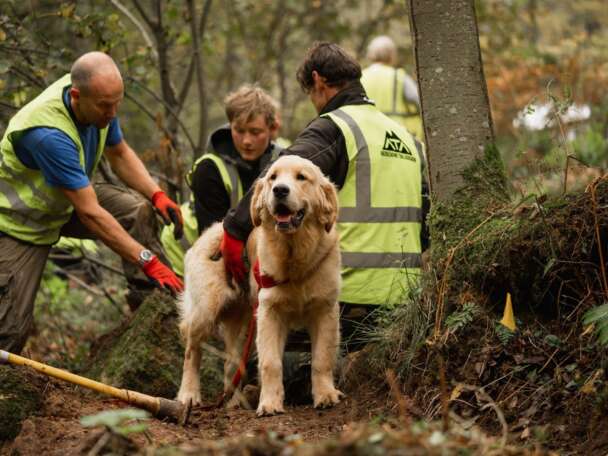Conferences
DIRTT 2.0 European Trail Builder Sector Survey
New Insights into the Evolving European Trail Building Industry: Key Takeaways from the DIRTT 2.0 European Trail Builder Sector Survey. New survey offers comprehensive overview of the current state of the trail building sector in Europe, highlights a developing industry structure, competencies, and emerging trends.

We at Developing Mountain Biking in Scotland (DMBinS) are proud to be a founding partner and, although we are now no longer able to be funded by the EU Funding, we are still a partner within the DIRTT steering group.
The reason we are still so keen to be part of DIRTT is for Scottish, and UK, mountain biking to feed into and benefit from the learnings of important pieces of research like this 'DIRTT 2.0 European Trail Builder Sector Survey'.
It is vital that we understand what is required to support the growth and quality of trail building education and certification will help us to sustainably grow the trail network in Scotland.
FULL PRESS RELEASE
The recently released DIRTT 2.0 European Trail Builder Sector Survey provides the most detailed overview of the European trail building sector to date. Conducted by Dr. Tom Campbell from Edinburgh Napier University as part of the Developing Inter-European Resources for Trail Building Training (DIRTT) project, the survey uncovers key insights into the industry’s structure, core competencies, and emerging trends. The findings will inform the development of a trans-European trail builder certification scheme, slated for launch by 2026.
DIRTT is a collaborative project aimed at establishing consistent standards for sustainable trail building practices across Europe. The project’s ultimate goal is to develop a standardized certification and training framework that equips trail builders with the necessary skills to meet both environmental and community needs. The survey findings are a critical component of the DIRTT project’s long-term vision of creating a robust and professionalized trail building sector in Europe.
Assoc Prof Campbell’s research, which surveyed professionals across the continent, presents 5 key takeaways that highlight the emerging trends in the current structure of the sector:
1. Industry composition: Small but experienced
The trail building sector is predominantly made up of small, experienced organisations. Nearly half of the respondents have over a decade of experience, with the majority working in teams of three or fewer employees. Interestingly, the size of the organisation tends to grow with longer involvement in the sector, indicating a steady maturation of the industry.
2. Multiplicity of roles
Trail builders wear many hats. Most professionals in the sector are involved in multiple aspects of trail planning, construction, maintenance, and management. This reflects the small size of the organisations, where versatility and adaptability are key to their operation.
3. Competency prioritisation
There is strong support for a wide range of competencies across different phases of trail building. While competencies during the construction phase, such as water management, were consistently deemed essential across all levels of responsibility, significant differences emerged during other work aspects, for example in the preparation and planning phases. In these earlier phases, competencies like permitting and cost estimation were prioritised more by those in higher-level roles, while roles with less autonomy focused more on technical aspects such as trail plans and specifications. This highlights the varying needs based on the level of responsibility within an organisation.
4. Sustainable and inclusive practices: A work in progress
While there is a reasonable level of knowledge regarding sustainable trail design, the application of inclusive principles remains less widespread. Only 10% of respondents reported always considering inclusivity when developing trails, highlighting a significant area for growth. Training in this area, particularly in understanding adaptive trail guidelines, is in high demand.
5. Certification preferences
The sector shows strong support for time-bound certification, with a preference for recertification every 3-5 years. This reflects a commitment to maintaining up-to-date competencies. There is also a clear preference for a certification model that involves national assessors, with nearly half favouring European coordination.
The findings from the DIRTT 2.0 European Trail Builder Sector Survey offer a comprehensive roadmap for supporting the industry’s ongoing growth and professionalization. With its focus on developing a trans-European certification scheme, the DIRTT project aims to foster a highly skilled workforce capable of building sustainable, accessible trails that meet the evolving needs of European communities and landscapes.
For more detailed insights, download the full survey report.
For more information on the DIRTT Project visit www.imba-europe.org/dirtt.
About DIRTT
DIRTT (Developing Inter-European Resources for Trail Building Training) is a collaborative initiative led by IMBA Europe, focused on creating a trans-European framework for training and certification in sustainable trail building.
The international project group representing both volunteer and professional trail builders, education providers, municipalities and tourist destinations work on developing the existing competence framework into a European-wide trail builder certification program in DIRTT 2.0.
You may also like
UK TRAILS PROJECT LAUNCHES NATIONWIDE TRAILS SURVEY

Scottish Trail Fund – Now open for Grant Applications!

Tweed Valley Fringe Events for the Cycling World Championships

SUPPORT SCOTTISH MOUNTAIN BIKING!
Become a Supporter